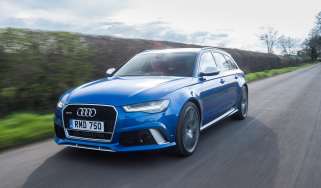Discontinued cars: departing performance icons you should buy used
The performance car market is set to see drastic change over the coming years, and 2022 has seen a slew of casualties
Over the next few years we’ll be saying ‘au revoir’ and ‘sayonara’ to plenty more iconic evo cars as their makers turn off their fuel pumps and switch on the chargers. Icons that have thrilled and fascinated, excited and engaged us. Heroes that some have loved and lost; for others an itch that still needs scratching. Whichever cliché applies, there’s an evo hero that meets your requirements.
We’ve selected a handful of performance cars that have been issued their last rites and will be replaced by models that will deliver an altogether different driving experience when they debut with a bootful of batteries and an electric motor. So stop fantasising; now is the time to live that performance car dream.
Renault Sport Mégane
Renault Sport’s demise still hasn’t sunk in. It’s the performance sub-brand from the volume manufacturer that has delivered some of the very best driver’s cars. Impressing from the get-go with the marvellous 1998 Clio 172, the hot Clios and Méganes that followed rarely missed the mark and, even when they did, RS was quick to rectify matters.
Which made selecting just one example from the prestigious back catalogue harder still. Clio Trophys and Cups tug at the heartstrings like few others and are impossible to ignore on every trip to the classifieds, but since the last Renault Sport model was a Mégane that’s the page we’ve landed on here, specifically the Phase 2 RS Mégane (2010-2016) that was based on the third generation of the popular hatchback.
Even more specifically, we’re tempted by the facelift cars built from 2014 that gave us the 275 Trophy and Trophy-R. The latter falls outside our arbitrary £15,000 budget, but the former is on the money (in fact gen-1 cars start at around £11,000-12,000 and are every bit as inspiring as their nipped and tucked younger brothers).
Renault Sport kept it simple, with a Cup chassis one of the few options available for the 275 (it was standard on the R). That brought a stiffer spring and damper set-up and a limited-slip diff and added to the already five-star performance of the standard car. Combined with the punchy nature of the 2-litre turbocharged four – the induction and exhaust roar as you reached the engine’s peak is supercar nape-tingling – the 275 was one of the sweetest driving experiences you could get this side of a contemporary GT3.
There’s a deftness to everything the Mégane does. Its crisp steering allows for pin-point accuracy on the road; its taut body and the sharper reactions of its tweaked chassis manifest themselves not as a harsh accompaniment but a perfectly executed display of precision dynamics where every input is met with a clarity of action and a purity of response. The 275 Trophy felt peak Renault Sport when it was new; five years on, it remains a pinnacle of the hot hatch genre.
Stretch your finances to a Trophy-R and the Akrapovic exhaust enhances the soundtrack while the Ohlins dampers and composite coil springs apply a further level of dynamic polish, but you’ll need some good contacts to track one down and budget nearly double what you’d need for a regular Trophy. A more affordable option could be the 275 Cup‑S, which had the Cup chassis as standard while leaving the R’s Ohlins and Cup 2 tyres on the options list.
Ultimately, any of this trio of mega Méganes would get our vote. At a time when VW got serious about its Golf R and Ford chased headlines with the third generation of Focus RS, the Mégane 275 remained the benchmark and still does today.
Nissan GT-R (R35)
Fourteen years – that’s how long ago it was that we crowned Nissan’s R35 GT-R evo Car of the Year. Blending muscle car with supercar, the GT-R triumphed over a line-up that included an Aston Martin Vantage 4.7, Gallardo LP560-4, Alfa’s delectable 8C Competizione, Porsche’s 911 GT2 (997) and Renault Sport’s unhinged Mégane R26.R. The GT-R took them all on and strode to the podium. It was the car’s one and only appearance at eCoty, though with hindsight the latest Nismo edition that we have just said goodbye to should have been at eCoty ’21. In fact a few of us could probably make a case for a GT-R being present at every eCoty since its 2008 debut – that’s how highly regarded Nissan’s monster is.
There are some who are lukewarm to the R35, impressed by its capability but left cold by its execution, and then there are those who adore it, admiring every strand of its DNA. Where some see an uncouth and rather industrial powertrain, others revel in a car straining at the seams with character and personality.
Its brutish appearance is a fair reflection of how it drives. It’s a car that requires you to be on your game, commit to the process of driving and be prepared for a workout if you want to experience it at its best and as its creators intended. A contemporary Porsche 911 Turbo is more clinical and operates across a wider bandwidth, but it lacks the raw passion of an R35.
As you’d expect with a career spanning 14 years, the GT-R saw constant updates, sometimes yearly. You’ll need to swot up to spot many of the changes, as Nissan took its continuous improvement mantra to extremes. But there isn’t a myriad of models to get lost in, so you can simply set your budget and go.
Early cars can be found for under £40,000, which is a sizeable chunk of money but then again it’s a sizeable chunk of performance icon that you’re getting in return. Increase your budget to the mid‑40s and you open yourself up to some impeccably well maintained and unmolested early examples or slightly newer models with 60,000-plus miles and a few modifications.
Talking of modifications, the R35 is ripe for them, which is why it’s so appealing to so many. Hand the specialists at Litchfield £1100 and they’ll take your standard GT-R to a Nismo-rivalling 590bhp; five grand gets you to 660bhp, and for the price of a three-year-old Fiesta ST-Line you can have 750bhp. As performance car blank canvases go, you’ll have to try hard not to find a tuning route that satisfies your desires.
Running costs need to be taken into consideration, with regular maintenance a must to keep that complex powertrain 100 per cent fit, and enjoying its launch control needs careful consideration – are the acceleration rewards worth the financial risk? But the GT-R continues to enthral and entertain, as desirable today as it was in 2008 when it claimed its eCoty crown.
Lotus Elise & Exige
Where to start with what could arguably be the greatest sports cars of all time? Not only did the Elise and Exige save Lotus from extinction, they have inspired generations to experience the thrill of driving in its purest form. And they continued to do so right up until Lotus finally called time on the Elise-based family of cars last year.
As a used proposition, the problem is which to choose. A Series 1 Elise feels a default choice: it’s the original and for many the purest. There’s a marvellous simplicity about everything it does, pure in its approach to driving and rewarding the driver across every mile. Those early cars, with their 1.8-litre K-series engines complete with soggy bread for a head gasket, might have had lowly outputs, but 725kg doesn’t require the thrust of a fighter jet to get it down the road, and when you factor in sublime steering, a magical ride and pin-sharp handling, if the thrill of driving was to be perfectly illustrated by a car, it’s an S1 Elise. It’s why we used an image of one on the dummy issue of evo way back when.
Even as it evolved into the S2 and on to the S3, the Elise never lost its focus or reason for being. Contemporary sports cars went upmarket, chased power and lap times, traded on a lifestyle rather than a principle, and all the while the diminutive Lotus carried on doing what it always did and focused on being the purist driver’s car it could be.
So which to go for? If, like yours truly, you were looking at an S1 Elise 18-24 months ago and thought £15,000 would get you a sorted, well-documented car, you’ll need to find at least another five grand today. Sorry. The good news is that an S2 with the more reliable Toyota VVTi engine won’t cost any more and the S3 is still available for under £30,000 for an early 2010-2013 car. So which one? An S1 for the purists, an S2 Elise S for what is possibly the best mix of everything the model has ever offered, or the S3 Final Edition for something special would be our suggestion.
Or perhaps you’d like your Elise a little more hardcore. And with a different name. In which case the Exige is where it’s at. A scaled-down Group C racer in looks, the Exige was Lotus turning up the wick and taking a more direct route to satisfy the needs and requirements of the burgeoning trackday fraternity.
Arriving four years after the Elise, the S1 Exige came with a more powerful K-series motor (177bhp or 190bhp), a clamshell rear body, hardtop roof, extra aero (100kg of downforce at 100mph) and cooling ducts to aid on-track braking. There was a wider track, revised spring and damper rates and an edge to its dynamics that sacrificed some of the Elise’s on-road pliancy for on-track focus.
It’s not the easiest of cars to get into or out of if you’re much taller than a nine-year-old, but once inside the Exige takes you on a journey of pure driving joy. It’s not as calm as an Elise and it requires more commitment to extract all that it has to offer, but when you do the Exige takes you back to a world of driving in its simplest forms.
The arrival of the S2 in 2004 saw the Exige receive a six-speed gearbox and a limited run of 50 cars with a 243bhp supercharged version of Toyota’s engine. This would go on to be the standard engine for the Exige S before a supercharged V6 motor was fitted from 2012 with the launch of the S3. Throughout its evolution the Exige has stayed true to its roots of being the track-focused member of the Elise family, its final 410 and 430 Cup iterations demonstrating that, two decades after the model’s launch, the Exige remains a force on road and track.
This track pedigree requires a £25,000 buy-in for an S2 (£40k-plus for the rare and collectable S1) with prices increasing depending on the specification, which can vary due to the Lotus business plan of the time of introducing limited-run specials throughout the model years. Our advice is not to be caught up on the spec, but focus on the condition. An S3 can be yours for around £40,000, and for some has the widest appeal thanks to its removable roof panel. Later S3s from 2018 onwards still command strong money, which some will baulk at if they judge a car by its badge and social media presence. For the rest of us, the Exige remains one of the most inspiring road and track cars of the last 20 years.
BMW M2 (F87)
It wasn’t the result we were expecting, and no doubt BMW felt the same, but in 2016 the 365bhp, rear-wheel-drive M2 came plum last in eCoty. Ouch. It was at a time when the current crop of M-cars were having a bit of a wobble, with their turbocharged engines – the N55 in the original M2’s case – overwhelming their chassis with skip-loads of power and torque just when the driver wasn’t expecting it. M had dropped the ball.
It quickly picked it up though, because for the 2018 M2 Competition not only had a more sophisticated S55 motor been installed, but so too a chassis that could manage its 405bhp way better than the original could its 365bhp. The Comp also demonstrated that within the M2 was a chassis that was balanced, faithful, responsive and communicative – all the things the standard M2 wasn’t. And then in 2020 the 444bhp M2 CS went one further and demonstrated exactly what you could get from the F87 model by cleaning up at eCoty.
So why are we recommending the original? Because those early cars are now on the market for £30,000 or less and, even with their faults, that’s a hell of a lot of opportunity for the money, because the original M2 offers a platform on which to apply some highly developed and much-needed modifications courtesy of the burgeoning BMW aftermarket.
In terms of breathing some life into the twin-scroll turbocharged 3-litre straight-six, the options range from an ECU remap with accompanying filter and exhaust upgrades that will get you within striking distance of the Comp’s 400bhp for around £1500. Or you can go a stage further and upgrade the turbocharger for a faster-responding unit that will kick on past 450bhp. You’ll want to budget for an intercooler, too, but £2500-3000 should see you on your way.
In terms of the chassis, the original M2’s weakest point, the likes of Bilstein and Nitron have you covered, due in part to their willingness to work with marque specialists to develop bespoke kits rather than expecting you to use off-the-shelf items. Both sets of upgraded components offer further adjustment on the car, too, with most specialists suggesting Bilstein’s B16 PSS110 damper with unique valving for road use or Nitron’s more technical damper and spring combo providing a more track-orientated set-up. Budget for a geo session, too, and for around £5000 you’ll have an M2 with Competition-rivalling performance for considerably less (the cheapest Comps are touching £40,000). Although, as with any project, you’re unlikely to stop there and will soon be eying up Alcon brake conversions, some seriously sticky rubber and a set of lighter forged gold wheels (too much?) to fit it to. We wouldn’t blame you.
As a road and track car, an early M2 with some sensible investment very quickly leaps off the bottom of the pile and firmly establishes itself as a great used driver’s car.
Lamborghini Aventador
In more ways than one, a V12 Lamborghini is not a purchase for the faint-hearted. This is purebred supercar territory, with bills as alarming as the thrills are exciting.
In today’s world of excess-all-areas styling, Luc Donckerwolke’s Murciélago design remains as fresh and clean as it was in 2001, a simple look that still manages to deliver a head-turning, neck-snapping reaction two decades on. It has it all, from its low stubby nose to its never-ending rear deck, the drama of its scissor doors and a footprint to make the jaws of a width restrictor salivate. It’s supercar theatre at its best.
And it continued with the Aventador, a wedge of exotica that unashamedly stuck to Lamborghini’s iconic supercar DNA to deliver a unique driving experience that only a car from Sant’Agata Bolognese can deliver.
Yes, there are some traditional Italian supercar hurdles to overcome. It requires suppleness of limb to get in and out, and when you’re inside either car you can’t see much of the outside world. For some the seating positioning is crippling, for others merely excruciating. But it’s oh so worth it.
From pulling that driver’s door down to hearing the starter motor spooling as it wakes those 12 cylinders – in the case of the Murciélago a V12 that could trace its roots back to the company’s very first, evolving over five decades from 3.5 litres and 270bhp to an astonishing 6.5 litres and 690bhp – it remains a moment to savour and drink in.
It’s no less an experience with Lamborghini’s second V12 engine, which made its debut in the Aventador in 2011. It had more of everything thanks to parent company Audi providing the means for an all-new 6.5-litre motor. That engine has seen the Aventador through its entire life cycle and has officially bowed out with the swansong Ultimae.
Purchasing a Lambo V12 is not a spur-of-the-moment decision, and it certainly isn’t one to be taken lightly, not least because dropping £130,000 on a Murciélago and at least an extra £30,000 on the earliest of Aventadors is a financial commitment that requires a serious conversion with your supercar finance broker of choice. Possibly several.
Yet, if you can raise the readies, we would strongly recommend you do have an example of Lamborghini’s icon in your life, no matter how briefly. Others will steer you towards equivalent Ferraris, with their wider appeal and an even more iconic nameplate. But there is something about driving a Lamborghini that no other car can replicate.
It generates a smile from both those fortunate to be sitting inside and those lucky enough to spot it running down a road. Yes, the later Murciélago SV and Aventador SVJ models aren’t for the shy and retiring types (what Lamborghini is?), but either model is a prime piece of automotive iconography. As the automotive world rummages around looking for a plug, Lamborghini’s raucous and exuberant pair will still be thrilling those fortunate to be in their presence.
This story was first featured in evo issue 298.







